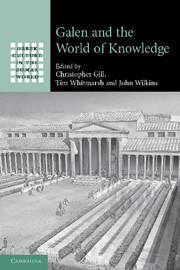Book contents
- Frontmatter
- Contents
- Notes on contributors
- Note on conventions
- Preface
- Introduction
- 1 Galen's library
- 2 Conventions of prefatory self-presentation in Galen's On the Order of My Own Books
- 3 Demiurge and Emperor in Galen's world of knowledge
- 4 Shock and awe: the performance dimension of Galen's anatomy demonstrations
- 5 Galen's un-Hippocratic case-histories
- 6 Staging the past, staging oneself: Galen on Hellenistic exegetical traditions
- 7 Galen and Hippocratic medicine: language and practice
- 8 Galen's Bios and Methodos: from ways of life to path of knowledge
- 9 Does Galen have a medical programme for intellectuals and the faculties of the intellect?
- 10 Galen on the limitations of knowledge
- 11 Galen and Middle Platonism
- 12 ‘Aristotle! What a thing for you to say!’ Galen's engagement with Aristotle and Aristotelians
- 13 Galen and the Stoics, or: the art of not naming
- Bibliography
- Index
6 - Staging the past, staging oneself: Galen on Hellenistic exegetical traditions
Published online by Cambridge University Press: 06 August 2010
- Frontmatter
- Contents
- Notes on contributors
- Note on conventions
- Preface
- Introduction
- 1 Galen's library
- 2 Conventions of prefatory self-presentation in Galen's On the Order of My Own Books
- 3 Demiurge and Emperor in Galen's world of knowledge
- 4 Shock and awe: the performance dimension of Galen's anatomy demonstrations
- 5 Galen's un-Hippocratic case-histories
- 6 Staging the past, staging oneself: Galen on Hellenistic exegetical traditions
- 7 Galen and Hippocratic medicine: language and practice
- 8 Galen's Bios and Methodos: from ways of life to path of knowledge
- 9 Does Galen have a medical programme for intellectuals and the faculties of the intellect?
- 10 Galen on the limitations of knowledge
- 11 Galen and Middle Platonism
- 12 ‘Aristotle! What a thing for you to say!’ Galen's engagement with Aristotle and Aristotelians
- 13 Galen and the Stoics, or: the art of not naming
- Bibliography
- Index
Summary
INTRODUCTION
The staging of an authorial self in multiple venues, contexts and media (including visual demonstration, oral performance and written text) was neither a uniquely Galenic nor a uniquely second-century phenomenon. In medicine it reaches back at least to the Classical period in Greece. But, within extant Greek and Latin technical literature, many of the better attested, more diverse and more colourful acts of authorial self-presentation are Galen's. Through public anatomical dissections and vivisections of animals and through multiple self-presentations in his prolific literary production, he actively participated in the ‘display culture’ of his time, even while deploring it. Deftly adapting different literary forms to different audiences, purposes and subjects (and at times liberally contaminating genres), he conspicuously inserted himself into almost every part of his oeuvre, thereby ensuring that he himself became a vivid, forceful authorial presence in his works. Furthermore, for all his insistence on the possibility of arriving at an objective science of the human body, and despite his effort to identify criteria for establishing a univocal ‘scientific’ language that would be suitable to communicate such a trans-subjective, transpersonal science, he often departed from the depersonalised, self-effacing style of some – but far from all – earlier authors of technical literature, resorting instead to a personally charged rhetoric. The result is a multi-dimensional staging of his authorial selves that pervades his massive extant corpus to a degree matched by few, if any, ancient writers of technical texts.
- Type
- Chapter
- Information
- Galen and the World of Knowledge , pp. 132 - 156Publisher: Cambridge University PressPrint publication year: 2009
- 7
- Cited by



